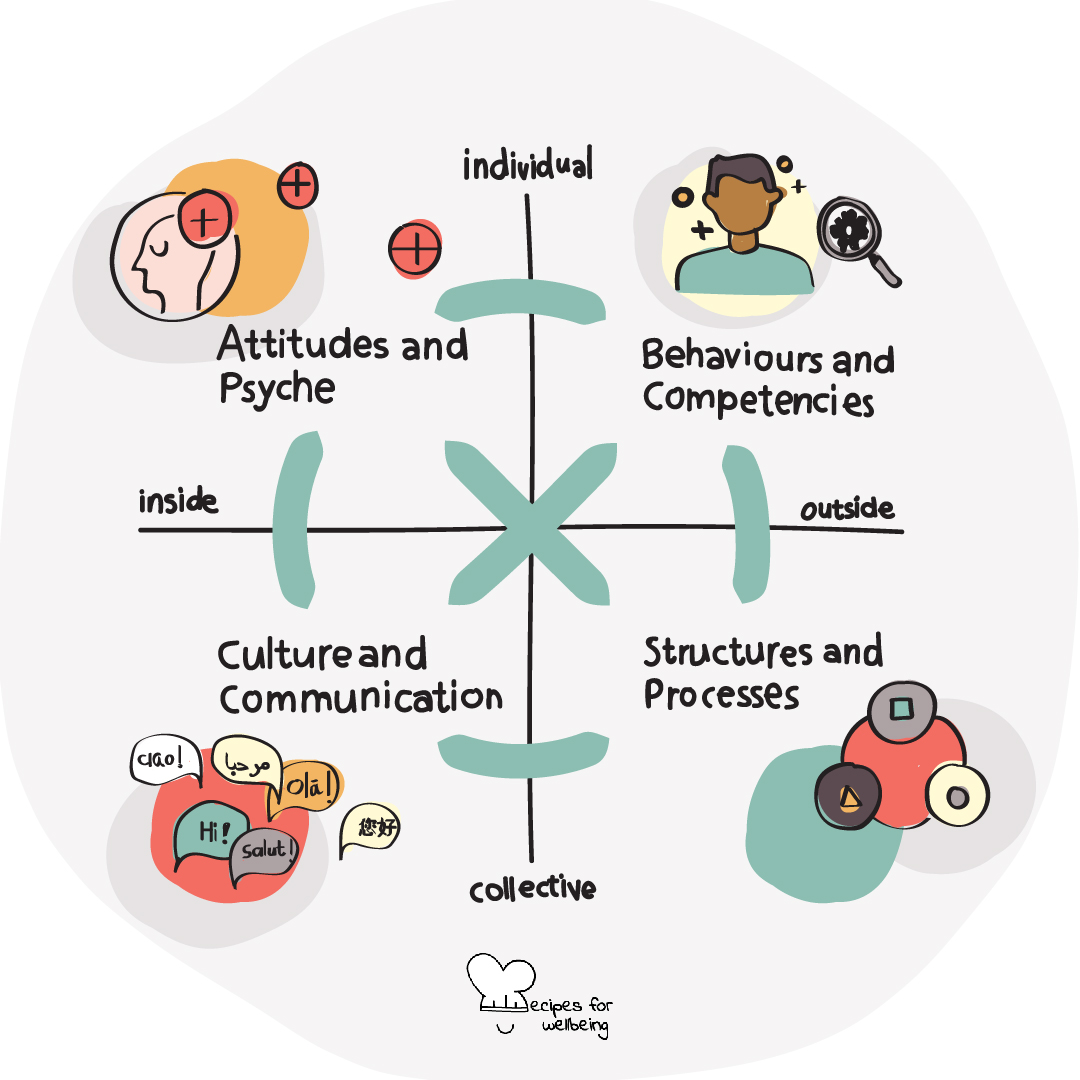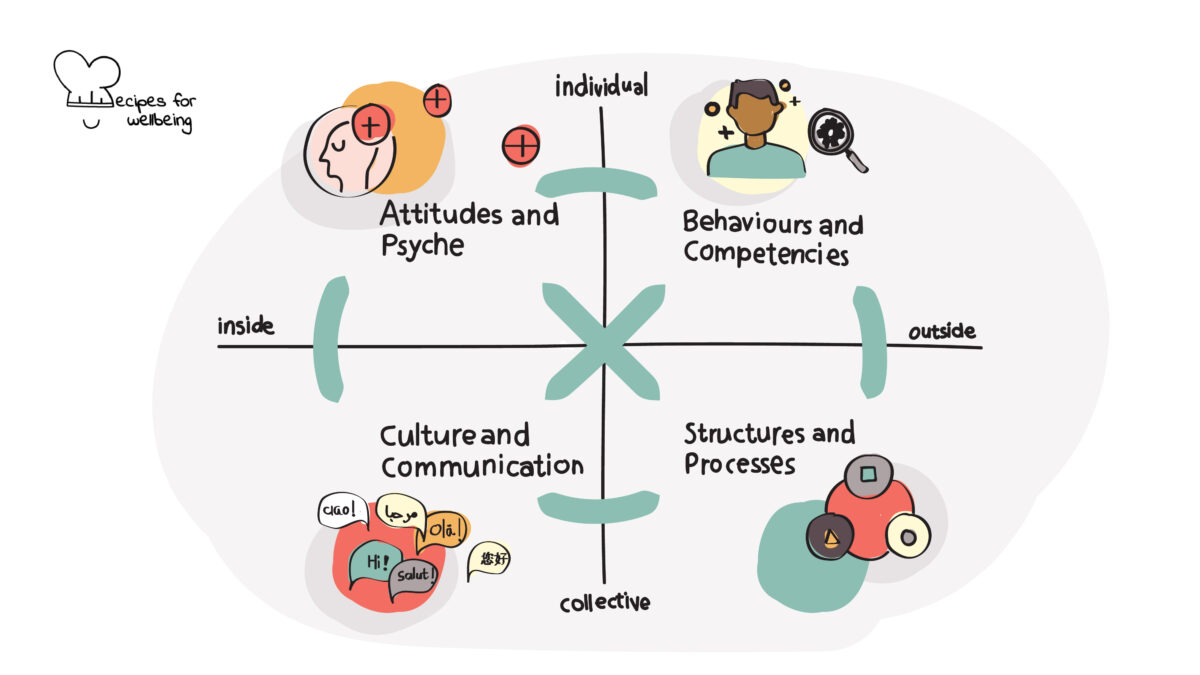
The AQAL model
Despite their apparent use of facts, figures, objectivity, concreteness and responsibility, organisations are in truth full of subjectivity, abstraction, riddles, invention and arbitrariness. This interplay of external and internal factors makes leadership and cooperation very complex. Most companies seek to master this complexity through processes, role descriptions and target agreements, and require of the employees a common understanding of standard situations. By largely ignoring the internal dimension, however, they pay a high price. Your employees are less satisfied, innovative, and motivated. To change this, we must consider both dimensions of life equally. ―Karl E. Weick
 Serves: Up to 20 people
Serves: Up to 20 people
 Difficulty: Medium
Difficulty: Medium
 Total time: 1.5 hours
Total time: 1.5 hours
 Ingredients: Flipchart paper, markers, and sticky notes in two colours (or a digital white board if doing this online), “New Work Needs Inner Work” book by Joana Breidenbach and Bettina Rollow (if you’re curious to find out more about it!)
Ingredients: Flipchart paper, markers, and sticky notes in two colours (or a digital white board if doing this online), “New Work Needs Inner Work” book by Joana Breidenbach and Bettina Rollow (if you’re curious to find out more about it!)
 Nutritional values: Self-Awareness, Clarity, Understanding, Self-Accountability, Empathy
Nutritional values: Self-Awareness, Clarity, Understanding, Self-Accountability, Empathy
 Serves: 11-25 people, 2-10 people
Serves: 11-25 people, 2-10 people
 Difficulty: Medium
Difficulty: Medium
 Total time: 61-120 minutes
Total time: 61-120 minutes
 Ingredients: Flipchart paper, markers, and sticky notes in two colours (or a digital white board if doing this online), “New Work Needs Inner Work” book by Joana Breidenbach and Bettina Rollow (if you’re curious to find out more about it!)
Ingredients: Flipchart paper, markers, and sticky notes in two colours (or a digital white board if doing this online), “New Work Needs Inner Work” book by Joana Breidenbach and Bettina Rollow (if you’re curious to find out more about it!)
 Wholebeing Domains: Awareness, Community, Liberatory Learning, Radical Care
Wholebeing Domains: Awareness, Community, Liberatory Learning, Radical Care
 Wholebeing Skills: Accountability, Emotional intelligence, Flourishing, Hosting conversations, Listening, Multiperspectivity, Non-judgement, Relating to Others, Self-awareness, Sense-making
Wholebeing Skills: Accountability, Emotional intelligence, Flourishing, Hosting conversations, Listening, Multiperspectivity, Non-judgement, Relating to Others, Self-awareness, Sense-making

The AQAL model
 Description
Description
A tool to map the external and internal dimensions of new work organisations.
In the book, New Work Needs Inner Work, authors Joana Breidenbach and Bettina Rollow observe how new work organisations aim towards a dynamic balance between “external” and “internal” dimensions that co-exist at all times. By “external” dimensions they refer to the “formal structures and processes, but also individual behaviours, forms of communication and competencies”. On the other hand, “internal” dimensions focus on “competencies and qualities that can only be experienced individually and subjectively”, such as feelings and emotions, expectations and needs, etc. These two dimensions influence each other, but many self-organised teams reduce external structures without building up the inner structures necessary to maintain this dynamic equilibrium.
This recipe introduces you to Ken Wilber’s AQAL model (All Quadrants, All Levels), adapted by Keks Ackerman CC BY–NC 2.0, which helps teams (and individuals) become aware of the interplay between the different dimensions. If you’re curious about new work, check out Joana Breidenbach’s TEDxTalk, “New Work Needs Inner Work”.
 Steps
Steps
Step 1 – Understanding the model (10’)
Take a look at the four quadrants, ensuring understanding within your team. Let’s observe first the two quadrants on the right.
- Bottom right • Collective & Outside • Structures & Processes. This quadrant is concerned with external, societal changes that are visible, such as the emergence of new platforms, products, and processes.
- Top right • Individual & Outside • Behaviours & Competencies. To adapt to those external changes, individuals must also change their behaviours and acquire new skills and knowledge.
Let’s turn to the two quadrants on the left.
- Top left • Individual & Inside • Attitudes & Psyche. For individuals to change their behaviours, they must also make adjustments to their inner awareness and personal attitude. Competencies such as self-contact and meta-reflection are essential here.
- Bottom left • Collective & Inside • Culture & Communication. Of course, all these changes will have an impact on the less visible collective cultural domain: how people relate to each other in a team, how they communicate, how they resolve conflicts. Competencies such as multiperspectivity and navigating uncertainty are critical here.
Of course, all quadrants influence each other (rather than it being a linear process from one quadrant to the next).
Step 2 – Mapping (10’)
If you are doing this in-person, give your team members a few sticky notes that they can write on. We recommend using two different colours, one colour for the ‘things that are working well’ and the other colour for the ‘things that are not working well’. If doing this online, share the link to the collaborative whiteboard (we advise you to prepare this in advance). Invite them to do an assessment of the team and place their sticky notes against the quadrants:
- What is working well? Where are we thriving?
- What is not working well? Where are we struggling?
It is important to note that different participants might perceive the same situation in opposite ways, and that’s okay. This mapping helps to raise awareness of visible and invisible dynamics. Sample statements:
- Collective & Outside • Structures & Processes. On the positive side, team members might write something like: “Empowering onboarding process” or “Fair salary compensation scheme”. On the negative side, team members might write something like: “Hierarchical management structure” or “Intransparent offboarding process”.
- Individual & Outside • Behaviours & Competencies. On the positive side, team members might write something like: “Alignment between organisational and individual values”. On the negative side, team members might write something like: “Lack of peer-support”.
- Individual & Inside • Attitudes & Psyche. On the positive side, team members might write something like: “Ability to receive feedback gracefully”. On the negative side, team members might write something like: “Difficult to find a balance between individual responsibility and accommodating for individual needs”.
- Collective & Inside • Culture & Communication. On the positive side, team members might write something like: “Empathetic communication” or “Engaged feedback”. On the negative side, team members might write something like: “Violent communication” or “Critical feedback”.
Step 3 – Sense-making (60’)
Notice patterns (and differences) in people’s mapping of the team/organisation. Facilitate a conversation to clarify what is meant with the various sticky notes.
Step 4 – Moving forward (10’)
Align on the most critical areas for improvement that you will tackle (as individuals but also as a collective). Repeat this mapping every 6 months or so to see what’s changed. You may wish to check out our other recipe “The iceberg model” for a tool to surface what is behind visible individual behaviour (useful especially for the top left quadrant in the AQAL model).


 Arabic
Arabic Chinese (Simplified)
Chinese (Simplified) Dutch
Dutch English
English French
French German
German Italian
Italian Portuguese
Portuguese Russian
Russian Spanish
Spanish